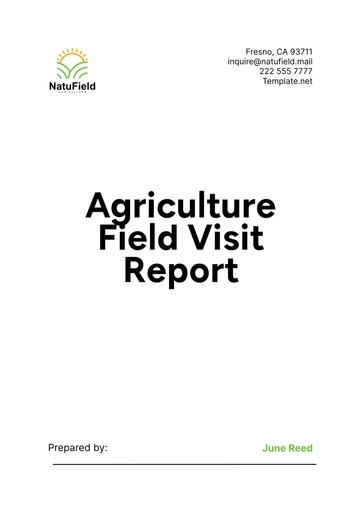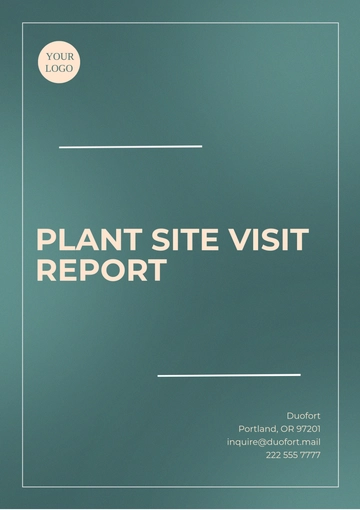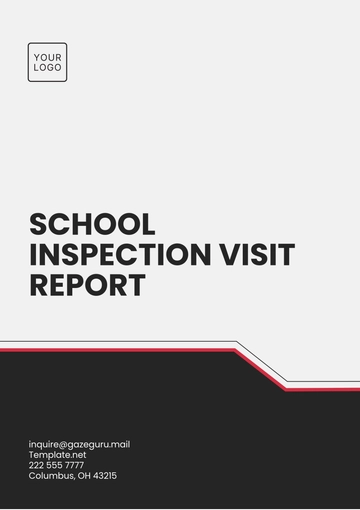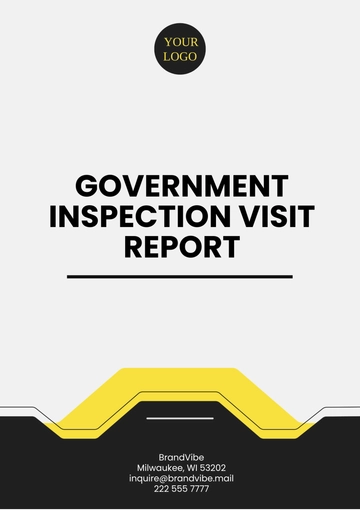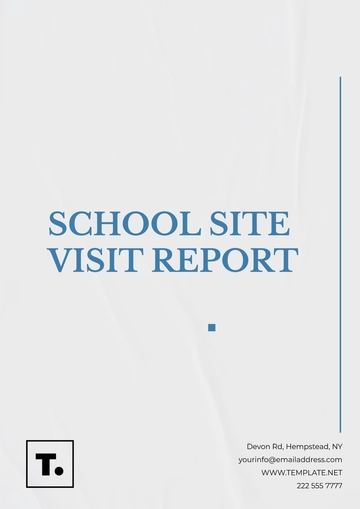Free Agriculture Field Visit Report
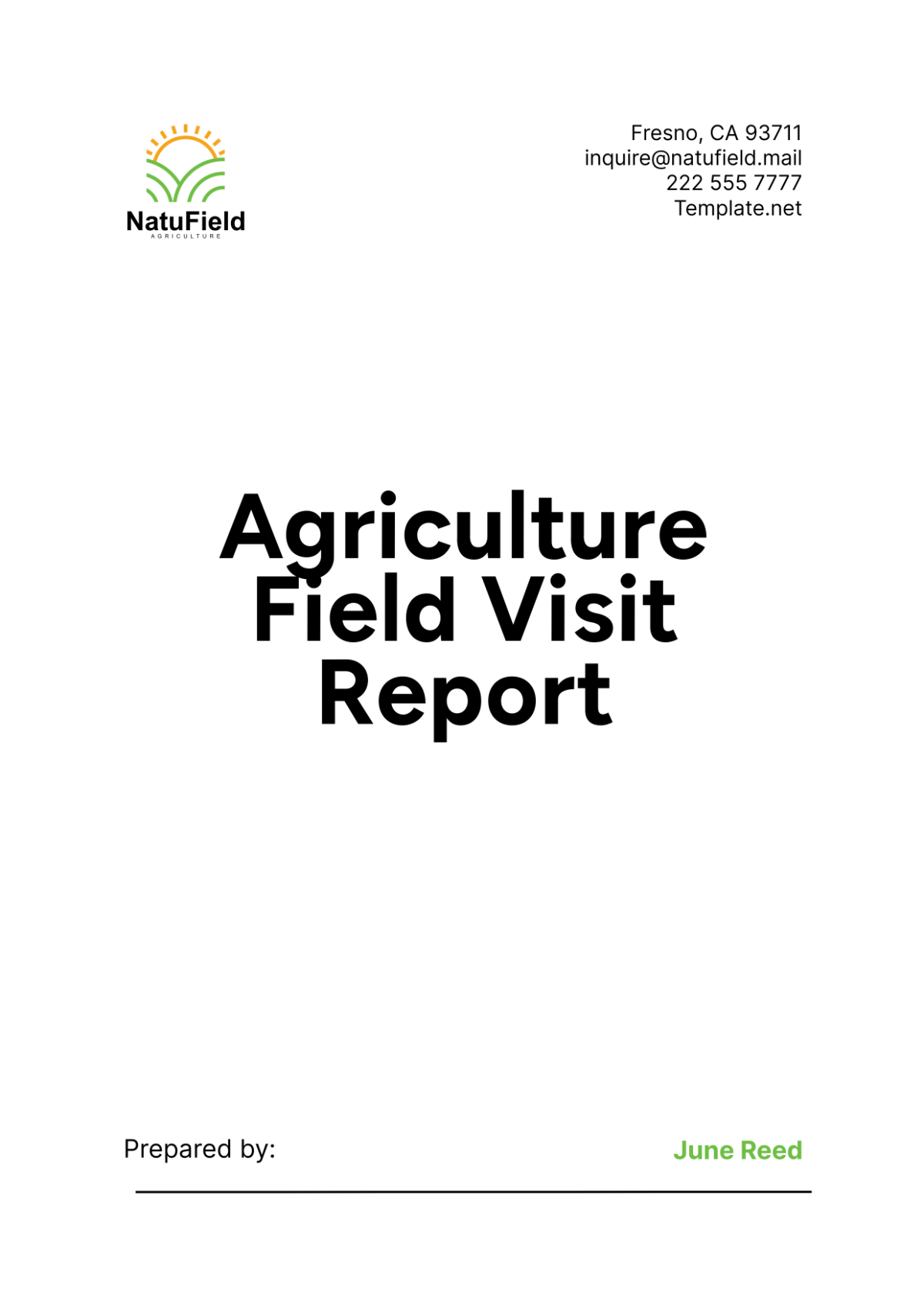
Executive Summary
This comprehensive Agriculture Field Visit Report is prepared by [Your Company Name] to provide a detailed overview of the field visit conducted from [Start Date] to [End Date] at our agricultural sites located in [Location]. The purpose of the visit was to assess current farming practices, evaluate crop health, inspect infrastructure, and identify areas for improvement. This report summarizes the observations, findings, and recommendations from the field visit, aiming to enhance operational efficiency, sustainability, and productivity.
1. Introduction
1.1 Purpose of the Field Visit
The primary objectives of the field visit were multifaceted, aiming to provide a comprehensive overview of the current state of our agricultural operations. Understanding the intricate details of our farming practices and their outcomes is crucial for driving improvements and ensuring the long-term sustainability of our agricultural business. Here, we delve deeper into each objective:
1.1.1 Assess the Current State of Crop Health and Growth
One of the core objectives was to thoroughly assess the health and growth of our crops. This involves examining various aspects such as:
Growth Patterns: Evaluating whether the crops are growing as expected, considering factors like plant height, density, and uniformity.
Leaf Color and Texture: Healthy crops typically exhibit vibrant green leaves with a consistent texture. Any deviations from this can indicate underlying issues such as nutrient deficiencies or diseases.
Yield Potential: Estimating the potential yield based on the current state of crop development. This helps in forecasting production levels and planning for market supply.
1.1.2 Evaluate the Effectiveness of Farming Practices and Techniques
The effectiveness of our farming practices and techniques directly impacts crop health and yield. During the field visit, we aimed to:
Analyze Planting Methods: Reviewing the planting techniques used, including seed spacing, depth, and the overall planting density to ensure optimal growth conditions.
Examine Irrigation Practices: Assessing the methods and schedules of irrigation to ensure that crops receive adequate water without wastage or over-irrigation, which can lead to waterlogging and nutrient leaching.
Review Pest and Disease Management: Evaluating the strategies employed to manage pests and diseases, including the use of chemical pesticides, biological controls, and integrated pest management (IPM) practices.
1.1.3 Inspect the Condition of Agricultural Infrastructure
The condition of our agricultural infrastructure is vital for maintaining high productivity and efficiency. Key infrastructure elements inspected included:
Irrigation Systems: Checking the functionality and efficiency of our irrigation systems, including drip and sprinkler setups. This ensures that water is being distributed evenly and efficiently across all crops.
Storage Facilities: Inspecting the storage facilities for any signs of damage, pest infestations, or other issues that could compromise the quality and safety of stored produce.
Machinery and Equipment: Evaluating the condition and performance of farm machinery and equipment, such as tractors, harvesters, and seeders. Well-maintained machinery is essential for efficient farming operations and minimizing downtime.
1.1.4 Identify Challenges and Areas for Improvement
By identifying existing challenges and areas that require improvement, we can develop targeted strategies to address them. This includes:
Resource Management Issues: Identifying inefficiencies in the use of resources such as water, fertilizers, and labor.
Operational Bottlenecks: Recognizing any operational bottlenecks that hinder productivity, such as outdated machinery or inadequate storage capacity.
Environmental Concerns: Addressing environmental challenges such as soil degradation, water scarcity, and the impact of climate change on crop production.
1.1.5 Gather Insights and Data to Inform Future Strategic Decisions
The data and insights gathered during the field visit are crucial for making informed strategic decisions. This involves:
Data Collection: Systematically collecting data on various parameters such as soil health, crop performance, and resource usage.
Analysis and Interpretation: Analyzing the collected data to identify trends, patterns, and correlations that can inform decision-making.
Strategic Planning: Using the insights gained to develop strategic plans for future agricultural practices, investments in infrastructure, and sustainability initiatives.
1.2 Scope of the Report
This report provides a detailed account of the field visit, covering the following key areas:
1.2.1 Crop Health Assessment
A comprehensive assessment of the health and growth of our crops is included in this report. This section details the methodology used, the crops assessed, and the findings from the evaluation.
1.2.2 Farming Practices Evaluation
This section evaluates the effectiveness of our current farming practices and techniques. It provides insights into planting methods, irrigation practices, pest and disease management, and their impact on crop health and productivity.
1.2.3 Infrastructure Inspection
An inspection of our agricultural infrastructure, including irrigation systems, storage facilities, and farm machinery, is detailed in this section. It highlights the condition of these assets and identifies any issues that need to be addressed.
1.2.4 Challenges and Areas for Improvement
This section identifies the challenges encountered during the field visit and areas where improvements are necessary. It provides a basis for developing targeted strategies to enhance our operations.
1.2.5 Recommendations
Based on the findings from the field visit, this section offers practical recommendations to address the identified challenges and improve our agricultural practices and infrastructure.
1.2.6 Conclusion
The report concludes with a summary of the key findings and recommendations, emphasizing the importance of continuous improvement and sustainable practices for the long-term success of our agricultural operations.
2. Crop Health Assessment
2.1 Overview of Crops Assessed
During the field visit, we assessed the following crops:
[Crop 1]: Known for its high yield and market demand, this crop is a significant part of our production.
[Crop 2]: A staple crop that provides substantial nutritional value and has consistent market performance.
[Crop 3]: This crop has been recently introduced to diversify our production and explore new market opportunities.
[Crop 4]: A specialty crop that requires specific growing conditions but offers high returns.
2.2 Methodology
The crop health assessment was conducted using a combination of visual inspections, soil testing, and data analysis. Key indicators evaluated included:
2.2.1 Plant Growth and Development
Observations were made on the overall growth patterns, including plant height, density, and development stages. This helps in understanding the general health and vigor of the crops.
2.2.2 Leaf Color and Texture
Healthy crops typically have vibrant, green leaves with a consistent texture. Any deviations, such as yellowing or wilting, were noted as potential indicators of nutrient deficiencies or diseases.
2.2.3 Presence of Pests and Diseases
A thorough inspection for signs of pest activity or disease was conducted. This included checking for visible pests, damage to plants, and symptoms of diseases such as spots, mold, or abnormal growth patterns.
2.2.4 Soil Moisture and Nutrient Levels
Soil samples were taken to test for moisture content and nutrient levels. Adequate soil moisture and balanced nutrient levels are essential for healthy crop growth. The results of these tests help in making informed decisions about irrigation and fertilization practices.
2.3 Findings
The table below summarizes the findings from the crop health assessment:
Crop | Growth and Development | Leaf Color and Texture | Pests and Diseases | Soil Conditions |
|---|---|---|---|---|
[Crop 1] | Robust growth, average height: [value] inches | Healthy green leaves, no damage | Minimal pest activity, few instances of [specific pest] | Optimal moisture and nutrient levels |
[Crop 2] | Slower growth, average height: [value] inches | Yellowing and wilting, nutrient deficiency | Presence of [specific pest], minor damage | Low nitrogen levels, requires attention |
[Crop 3] | Excellent growth, uniform height | Vibrant green, healthy texture | No significant issues detected | Optimal nutrient levels |
[Crop 4] | Uneven growth, varying height | Spots and blemishes, possible fungal infection | High incidence of [specific pest] | Excessive moisture, likely over-irrig |
3. Farming Practices Evaluation
3.1 Overview of Practices Evaluated
The evaluation focused on the following farming practices:
Planting techniques
Irrigation methods
Pest and disease management
Fertilization and soil management
3.2 Findings
3.2.1 Planting Techniques
Observations: Planting density was generally adequate, but some fields showed signs of overcrowding.
Impact: Overcrowding can lead to competition for resources and reduced yields.
Recommendations: Adjust planting density to optimize resource use and improve crop health.
3.2.2 Irrigation Methods
Observations: A mix of drip and sprinkler irrigation systems were in use. Some areas exhibited signs of over-irrigation.
Impact: Over-irrigation can lead to waterlogging and nutrient leaching, affecting crop growth.
Recommendations: Implement more precise irrigation scheduling and monitoring to avoid over-irrigation.
3.2.3 Pest and Disease Management
Observations: Integrated Pest Management (IPM) practices were partially implemented. Chemical pesticides were used extensively.
Impact: Over-reliance on chemical pesticides can lead to pest resistance and environmental harm.
Recommendations: Enhance IPM practices by incorporating biological controls and reducing chemical pesticide use.
3.2.4 Fertilization and Soil Management
Observations: Fertilization practices varied across fields, with some showing signs of nutrient imbalance.
Impact: Improper fertilization can lead to nutrient deficiencies or toxicities, affecting crop health.
Recommendations: Conduct regular soil testing and tailor fertilization practices to specific crop needs.
4. Infrastructure Inspection
4.1 Irrigation Systems
4.1.1 Overview
The field visit included a thorough inspection of the irrigation systems, focusing on their functionality and efficiency.
4.1.2 Findings
Drip Irrigation: Generally well-maintained, but some emitters were clogged, affecting water distribution.
Sprinkler Irrigation: Effective in most areas, but a few sprinklers showed signs of wear and tear, leading to uneven water application.
Recommendations: Regular maintenance and cleaning of drip emitters and replacement of faulty sprinklers to ensure efficient water use.
4.2 Storage Facilities
4.2.1 Overview
The storage facilities were inspected to assess their condition and capacity.
4.2.2 Findings
Condition: Most storage facilities were in good condition, but some showed signs of wear, including minor structural damage and pest infestations.
Capacity: Current storage capacity is adequate for existing production levels, but additional capacity may be needed for future expansion.
Recommendations: Repair structural damages, implement pest control measures, and consider expanding storage capacity to accommodate future growth.
4.3 Machinery and Equipment
4.3.1 Overview
The inspection covered the condition and functionality of farm machinery and equipment.
4.3.2 Findings
Condition: Most machinery was well-maintained, but some older equipment showed signs of wear.
Functionality: All equipment was operational, but some could benefit from upgrades to improve efficiency.
Recommendations: Regular maintenance of existing machinery and phased upgrades to modern equipment to enhance operational efficiency.
5. Challenges and Areas for Improvement
5.1 Key Challenges Identified
5.1.1 Climate Variability
Impact: Unpredictable weather patterns have affected crop growth and yields.
Solution: Implement climate-resilient farming practices, such as crop diversification and use of drought-resistant varieties.
5.1.2 Pest and Disease Management
Impact: Increased incidence of pests and diseases has led to crop damage and yield losses.
Solution: Strengthen IPM practices and explore the use of biological controls to reduce dependency on chemical pesticides.
5.1.3 Resource Management
Impact: Inefficient use of water and fertilizers has led to wastage and nutrient imbalances.
Solution: Optimize irrigation and fertilization practices through precision agriculture techniques and regular soil testing.
5.2 Areas for Improvement
5.2.1 Soil Health
Observation: Some fields exhibited signs of soil degradation and nutrient deficiencies.
Recommendation: Implement soil health improvement practices, such as cover cropping, crop rotation, and organic amendments.
5.2.2 Crop Diversity
Observation: Reliance on a limited number of crop varieties increases vulnerability to pests and diseases.
Recommendation: Introduce a wider range of crop varieties to enhance resilience and reduce risk.
5.2.3 Technology Integration
Observation: Limited use of advanced technologies in some areas.
Recommendation: Increase the adoption of precision agriculture technologies, such as GPS-guided equipment and remote sensing, to improve efficiency and productivity.
6. Recommendations
6.1 Short-term Recommendations
6.1.1 Immediate Actions
Address Pest Infestations: Implement targeted pest control measures to address current infestations, particularly for [Crop 4].
Soil Nutrient Management: Apply appropriate fertilizers to address nutrient deficiencies identified in soil tests, particularly for [Crop 2].
6.1.2 Maintenance and Repairs
Irrigation System Maintenance: Conduct regular maintenance and cleaning of drip irrigation emitters and repair faulty sprinklers.
Storage Facility Repairs: Address structural damages and implement pest control measures in storage facilities.
6.2 Long-term Recommendations
6.2.1 Infrastructure Investments
Expand Storage Capacity: Plan for the construction of additional storage facilities to accommodate future production increases.
Upgrade Machinery: Phase out older machinery and invest in modern, efficient equipment to improve operational efficiency.
6.2.2 Sustainable Practices
Enhance IPM: Strengthen Integrated Pest Management practices by incorporating more biological controls and reducing reliance on chemical pesticides.
Improve Soil Health: Implement long-term soil health improvement practices, including regular soil testing, crop rotation, and organic amendments.
6.2.3 Technology Adoption
Precision Agriculture: Increase the adoption of precision agriculture technologies to optimize resource use and improve crop management.
Data Analytics: Utilize data analytics to monitor crop health, predict pest outbreaks, and make data-driven decisions.
6.3 Training and Development
6.3.1 Employee Training
Observation: Limited knowledge and skills in some advanced farming practices and technologies among staff.
Recommendation: Implement regular training programs to upskill employees in advanced farming techniques, precision agriculture, and sustainable practices.
6.3.2 Community Engagement
Observation: Opportunities to enhance community engagement and support local farmers.
Recommendation: Conduct workshops and training sessions for local farmers on sustainable farming practices and technologies.
7. Conclusion
The field visit conducted by [Your Company Name] has provided valuable insights into our current farming practices, crop health, and infrastructure. While we have made significant progress in several areas, there are clear opportunities for improvement. By addressing the identified challenges and implementing the recommended actions, we can enhance our operational efficiency, sustainability, and productivity.
This comprehensive report serves as a roadmap for future actions and strategic decisions, ensuring that [Your Company Name] continues to lead in sustainable agriculture and achieve long-term success.
For further information or inquiries, please contact:
[Your Name]
[Your Position]
[Your Company Name]
[Your Company Email]
[Your Company Address]
[Your Company Number]
[Your Company Website]
[Your Company Social Media]
Date of Report: [Date]
- 100% Customizable, free editor
- Access 1 Million+ Templates, photo’s & graphics
- Download or share as a template
- Click and replace photos, graphics, text, backgrounds
- Resize, crop, AI write & more
- Access advanced editor
Document your field insights meticulously with Template.net's Agriculture Field Visit Report Template. Designed for professionals in the agriculture sector, this template helps you record observations and findings from on-site visits. Customize and edit using our AI editor tool to provide detailed analyses and recommendations, enhancing the strategic planning and operational efficiency of your agricultural projects.
You may also like
- Sales Report
- Daily Report
- Project Report
- Business Report
- Weekly Report
- Incident Report
- Annual Report
- Report Layout
- Report Design
- Progress Report
- Marketing Report
- Company Report
- Monthly Report
- Audit Report
- Status Report
- School Report
- Reports Hr
- Management Report
- Project Status Report
- Handover Report
- Health And Safety Report
- Restaurant Report
- Construction Report
- Research Report
- Evaluation Report
- Investigation Report
- Employee Report
- Advertising Report
- Weekly Status Report
- Project Management Report
- Finance Report
- Service Report
- Technical Report
- Meeting Report
- Quarterly Report
- Inspection Report
- Medical Report
- Test Report
- Summary Report
- Inventory Report
- Valuation Report
- Operations Report
- Payroll Report
- Training Report
- Job Report
- Case Report
- Performance Report
- Board Report
- Internal Audit Report
- Student Report
- Monthly Management Report
- Small Business Report
- Accident Report
- Call Center Report
- Activity Report
- IT and Software Report
- Internship Report
- Visit Report
- Product Report
- Book Report
- Property Report
- Recruitment Report
- University Report
- Event Report
- SEO Report
- Conference Report
- Narrative Report
- Nursing Home Report
- Preschool Report
- Call Report
- Customer Report
- Employee Incident Report
- Accomplishment Report
- Social Media Report
- Work From Home Report
- Security Report
- Damage Report
- Quality Report
- Internal Report
- Nurse Report
- Real Estate Report
- Hotel Report
- Equipment Report
- Credit Report
- Field Report
- Non Profit Report
- Maintenance Report
- News Report
- Survey Report
- Executive Report
- Law Firm Report
- Advertising Agency Report
- Interior Design Report
- Travel Agency Report
- Stock Report
- Salon Report
- Bug Report
- Workplace Report
- Action Report
- Investor Report
- Cleaning Services Report
- Consulting Report
- Freelancer Report
- Site Visit Report
- Trip Report
- Classroom Observation Report
- Vehicle Report
- Final Report
- Software Report







